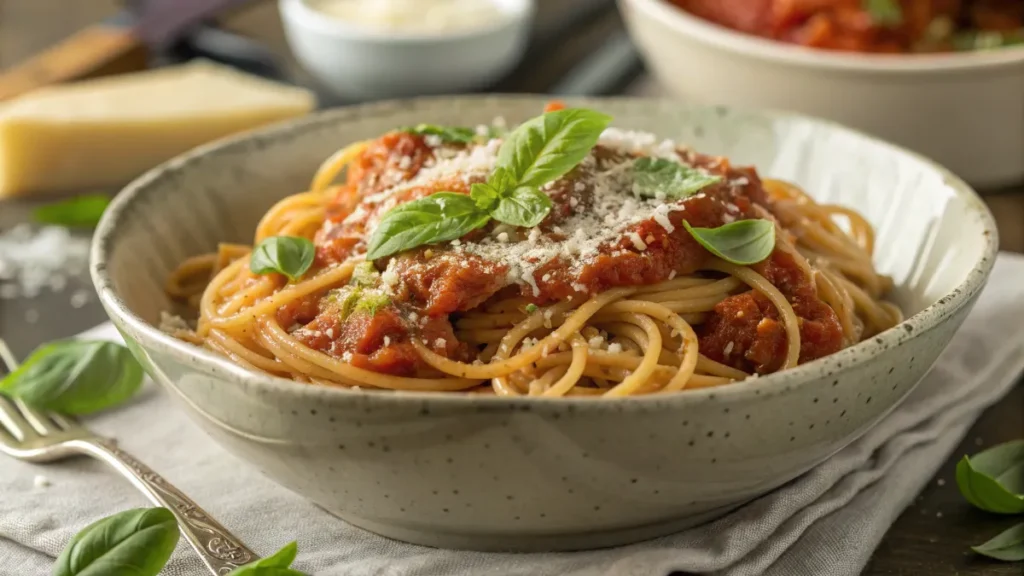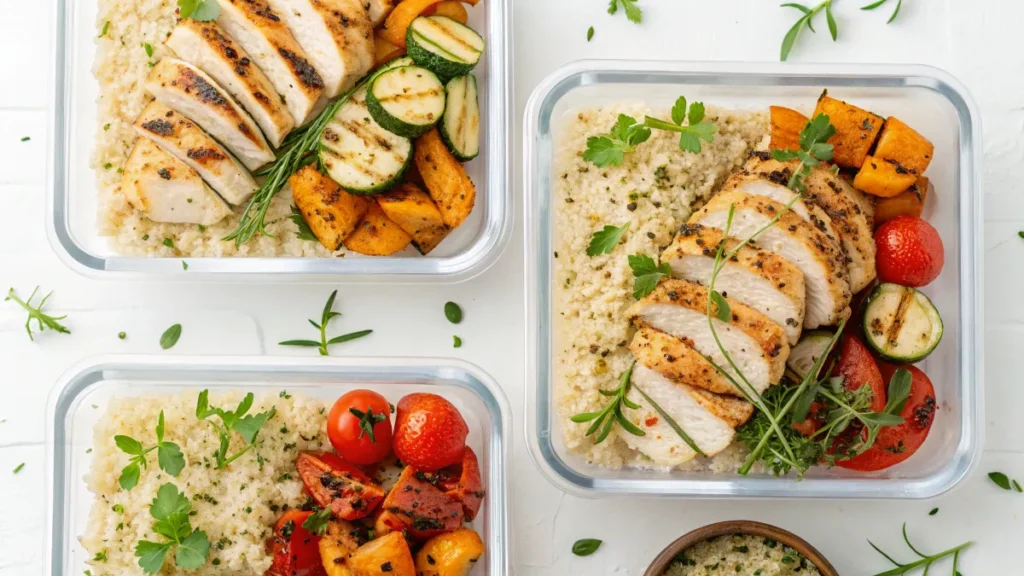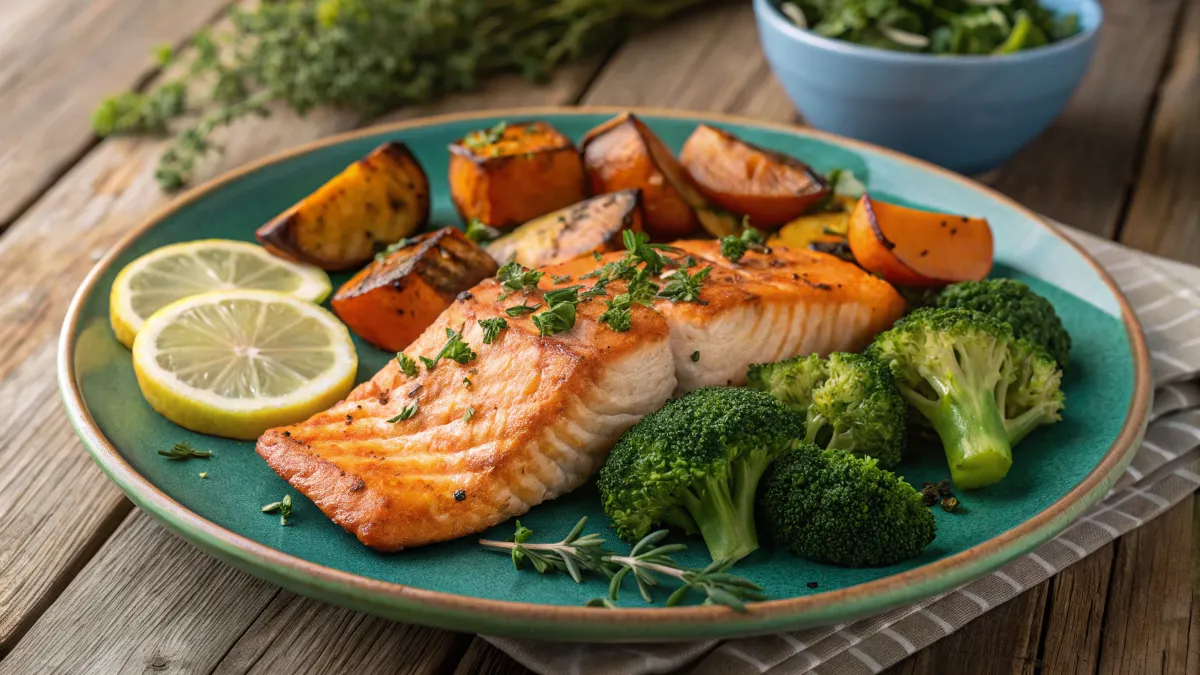What is an example of a gluten-free meal? If you’re exploring gluten-free options, you’re in the right place. This article highlights various gluten-free meals, from breakfasts to dinners and snacks, to help you enjoy a safe and satisfying diet. Whether you’re managing celiac disease or simply avoiding gluten for other reasons, these examples will inspire you to create tasty, nourishing dishes.
Table of Contents
Understanding Gluten-Free Meals
What Does a Gluten-Free Meal Include?
A gluten-free meal includes naturally gluten-free ingredients like fresh vegetables, proteins, and gluten-free grains. For instance, grilled chicken with roasted sweet potatoes and broccoli is a perfect example of a gluten-free meal.
Who Needs a Gluten-Free Diet?
- Celiac Disease Patients: Eating gluten damages their small intestine.
- Gluten Sensitivity Cases: They experience bloating, pain, or discomfort without a celiac diagnosis.
- Non-Medical Reasons: Some people adopt this diet for perceived health benefits.
Core Components of a Gluten-Free Meal
A well-balanced gluten-free meal typically includes:
- Proteins: Meat, fish, eggs, or tofu.
- Carbohydrates: Rice, quinoa, or gluten-free pasta.
- Vegetables: Fresh or steamed vegetables of any variety.
- Healthy Fats: Avocado, nuts, or olive oil.
Examples of Gluten-Free Breakfasts
For breakfast, what is an example of a gluten-free meal? Gluten-free pancakes made with almond flour, or smoothie bowls topped with fresh fruits and nuts, are excellent options.
Gluten-Free Pancakes and Waffles
Starting the day with a hearty breakfast is possible with gluten-free options like pancakes or waffles. These are made using almond flour, coconut flour, or gluten-free mixes. Top them with fresh fruits or maple syrup for a delightful morning treat.
- Recipe Example: Simply Recipes’ Gluten-Free Pancakes offers a foolproof way to enjoy pancakes without gluten.
- LSI Keywords: Almond flour pancakes, coconut flour waffles, celiac-safe breakfasts.
Smoothie Bowls
Smoothie bowls are naturally gluten-free and customizable. Blend a mix of frozen fruits, yogurt, and almond milk. Top with chia seeds, nuts, or shredded coconut for extra texture and nutrition.
Egg-Based Dishes
Scrambled eggs, omelets, or a vegetable frittata make excellent high-protein, gluten-free breakfast options. Adding spinach, mushrooms, or cheese can make them even tastier.
Examples of Gluten-Free Lunches
Grilled Chicken Salad
A fresh salad topped with grilled chicken, avocados, and a simple vinaigrette is both gluten-free and satisfying. Add quinoa or roasted chickpeas for a protein boost.
- Recipe Example: Serious Eats’ Grilled Chicken Salad showcases how versatile and filling a gluten-free salad can be.
- LSI Keywords: Gluten-free lunch ideas, healthy salad toppings, protein-packed meals.
Gluten-Free Sandwich Alternatives
Use gluten-free bread or wraps made from rice or tapioca flour. Fill them with turkey, lettuce, and a slice of cheese for a classic combination. For a low-carb option, use lettuce leaves instead of bread.
Soups and Stews
Many soups and stews are naturally gluten-free. Opt for homemade versions to avoid hidden gluten in store-bought broths. Favorites include chicken noodle soup with gluten-free noodles or lentil stew.
- Tip: Double-check that your broth or stock is labeled gluten-free to ensure safety.
Gluten-Free Dinner Options

Grilled Salmon with Vegetables
Grilled salmon paired with roasted vegetables like zucchini, asparagus, and sweet potatoes creates a nutritious and naturally gluten-free dinner. Season with olive oil, garlic, and herbs for a delicious flavor boost.
- Internal Tip: For more dinner ideas, explore this article on 15 Easy Gluten-Free Dinner Recipes for Family Tonight.
- LSI Keywords: Healthy gluten-free meals, roasted veggie recipes, high-protein dinners.
Gluten-Free Pasta Dishes
Pasta lovers can still enjoy their favorites using gluten-free pasta made from rice or quinoa. Toss with marinara or pesto sauce, and add grilled chicken or shrimp for protein.
Stir-Fry with Rice or Quinoa
A stir-fry is a simple way to incorporate plenty of vegetables and protein into your diet. Use tamari instead of soy sauce to ensure the dish remains gluten-free. Pair it with quinoa or jasmine rice for a wholesome meal.
Gluten-Free Snacks and Desserts
Rice Cakes with Toppings
Rice cakes are a versatile snack. Add peanut butter and banana slices for a sweet treat or top with hummus and cucumber for a savory option.
Trail Mix with a Twist
Make your own trail mix with gluten-free granola, dried fruits, nuts, and seeds. It’s a portable snack that keeps you full and energized.
Gluten-Free Brownies
Using almond or coconut flour, you can create indulgent, gluten-free brownies. These are perfect for satisfying your sweet tooth while staying on track.
Learn more about creating delicious snacks in this recipe: Protein Baked Oatmeal.
Gluten-Free Beverages
Smoothies and Shakes
Smoothies and shakes made with fresh fruits, vegetables, and gluten-free protein powders are excellent options. You can use almond milk, coconut water, or oat milk as a base. Add ingredients like spinach, bananas, or berries to enhance the flavor and nutrients.
- Pro Tip: Avoid prepackaged smoothie mixes unless they are labeled gluten-free, as they might contain hidden sources of gluten.
Herbal Teas and Infusions
Herbal teas, such as chamomile, mint, or hibiscus, are naturally gluten-free. However, always double-check flavored teas for any potential additives that may contain gluten.
Coffee and Specialty Drinks
Most coffee is naturally gluten-free. To keep specialty drinks safe, opt for gluten-free syrups and avoid processed creamers. For instance, a latte with almond milk and a hint of cinnamon is a warm and satisfying option.
FAQs About Gluten-Free Meals
What is an Example of a Gluten-Free Meal?
A classic example of a gluten-free meal is grilled chicken served with roasted sweet potatoes and steamed broccoli. It’s simple to prepare and naturally free of gluten.
Are All Gluten-Free Foods Healthy?
Not all gluten-free foods are inherently healthy. For example, gluten-free cookies or bread may contain more sugar and fats than their regular counterparts. Opt for whole, unprocessed foods whenever possible.
How Can I Be Sure a Meal is Gluten-Free?
Always check ingredient labels for hidden gluten. Look for certifications and avoid cross-contaminated products. Cooking at home is the safest way to ensure meals are gluten-free.
Can I Eat Out on a Gluten-Free Diet?
Yes, but it’s essential to research restaurants in advance. Many places now offer dedicated gluten-free menus. Ask questions about preparation methods to avoid cross-contamination.
Gluten-Free Meal Prep Tips

Plan Your Meals in Advance
Meal planning is a game changer when following a gluten-free diet. Write down a weekly menu, including breakfast, lunch, dinner, and snacks. For example, consider making grilled chicken with quinoa and vegetables for your lunchboxes. This not only saves time but ensures you always have a gluten-free option available.
- Tip: Use storage containers to separate portions for the week, which helps prevent accidental cross-contamination in your fridge.
Batch Cooking for Efficiency
Cooking larger portions of gluten-free meals can save time during busy weeks. For instance, prepare a big batch of gluten-free chili or soup and freeze individual portions. This way, you’ll always have a meal ready when you’re short on time.
Rotate Ingredients to Avoid Boredom
Eating the same meals can become monotonous. Mix up your choices by rotating different proteins, grains, and vegetables. One week, focus on salmon and asparagus, and the next, try a stir-fry with rice and shrimp.
Gluten-Free Grocery Shopping Tips
Stick to Naturally Gluten-Free Foods
Focus on whole, unprocessed foods like fresh fruits, vegetables, meat, and grains such as quinoa or rice. These are naturally gluten-free and less likely to have hidden ingredients.
Read Labels Carefully
Always check ingredient lists, even for items labeled “gluten-free.” Some products may still contain small traces of gluten due to processing. Avoid items that don’t have clear allergen labels or certifications.
Shop in the Right Sections
Look for gluten-free bread, pasta, and snacks in the dedicated gluten-free aisle. Specialty stores or online retailers often have a wider selection.
Keep a Stock of Essentials
Having a well-stocked pantry makes meal preparation easier. Consider keeping gluten-free flours, pasta, and canned goods like beans and tomatoes readily available.
Gluten-Free Dining Out
Choosing the Right Restaurant
Dining out can be enjoyable even on a gluten-free diet. Research gluten-free-friendly restaurants and check reviews to ensure they cater to dietary needs. Chain restaurants often provide allergen menus, making it easier to select safe options.
Ask Questions About Preparation
When ordering, confirm that meals are prepared without cross-contamination. For example, ask if the kitchen uses separate cooking utensils or fryers for gluten-free dishes.
Safe Meal Ideas When Eating Out
Salads with grilled chicken, steak with steamed vegetables, or baked fish with rice are classic examples of gluten-free meals that are widely available.
For more ideas about enjoying gluten-free meals outside your home, visit our guide on Soul Food Dinner Ideas.
Gluten-Free Meal Ideas for Kids
Fun and Healthy Breakfasts
Kids love gluten-free pancakes, smoothies, and scrambled eggs with cheese. Add fresh fruits or a sprinkle of chocolate chips for variety.
Lunchbox-Friendly Ideas
Prepare gluten-free wraps using lettuce or gluten-free tortillas. Fill them with turkey, cheese, and spinach. Include carrot sticks and hummus as a side.
Snack Time Favorites
Gluten-free cookies, yogurt parfaits, and homemade trail mix are kid-approved snacks.
For more inspiration, check out our article on High-Protein Breakfasts for Busy Professionals.
Conclusion
Following a gluten-free lifestyle doesn’t have to be restrictive or complicated. By focusing on naturally gluten-free ingredients, planning meals, and staying informed, you can enjoy delicious, safe, and satisfying meals every day. Remember, a little preparation goes a long way in making gluten-free living easier and more enjoyable.

